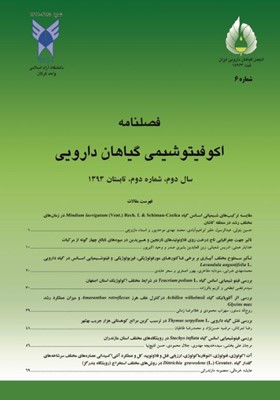بررسی فیتوشیمیایی اسانس گیاه Stachys inflata در رویشگاههای مختلف استان مازندران
محورهای موضوعی : اکولوژی محیطیمرجان علی بخشی 1 * , سیده خدیجه مهدوی 2 , جلال محمودی 3 , حسن قلیچ نیا 4
1 - کارشناس ارشد، گروه مرتع داری، واحد نور، دانشگاه آزاد اسلامی، نور، ایران
2 - استادیار، گروه منابع طبیعی، واحد نور، دانشگاه آزاد اسلامی، نور، ایران
3 - استادیار، گروه منابع طبیعی، واحد نور، دانشگاه آزاد اسلامی، نور، ایران
4 - عضو هیات علمی مرکز تحقیقات کشاورزی و منابع طبیعی استان مازندران
کلید واژه: اسانس, ترکیبهای شیمیایی, رویشگاههای مختلف استان مازندران, سنبله بادکنکی,
چکیده مقاله :
در این تحقیق بهمنظور بررسی کمیت و کیفیت مواد موثره اسانس گیاه دارویی سنبله بادکنکی (Stachys inflata L.)، سرشاخههای گلدار گیاه در اوایل خردادماه سال 1391 از سه رویشگاه مختلف استان مازندران جمعآوری و سپس در سایه خشک گردیدند. استخراج اسانس به روش تقطیر با آب (طرح کلونجر) بهمدت 4 ساعت انجام شد. ترکیبهای شیمیایی اسانسها با استفاده از دستگاههای گاز کروماتوگرافی گازی (GC) و گاز کروماتوگراف متصل به طیف سنج جرمی (GC/MS) شناسایی شدند. بازده تولید اسانس سرشاخههای گلدار دررویشگاههای مختلف از 1.3 تا 2.9 درصد بر حسب وزن سر شاخههای خشک گیاه متغیر بود و بهترتیب مواد موثره: ژرماکرن-دی (از 8.7 تا %9/16) و بی سیکلو ژرماکرن (از 11.2 تا % 6/16) در هر سه رویشگاه از بیشترین میزان در اسانس برخوردار بودند که این تفاوت میتواند ناشی از شرایط مختلف اکولوژیکی مناطق مورد مطالعه باشد.
1.Azarnivand, H., Gham Arbani, M., Sefidkon, F., and Tavili, A. 2010. Examination if effect of characteristic of ecology (soil, elevation) on quantity and quality essential oil flower and leaf Achillea millefolium L. subsp. Millefolium. Journal of researches medicinal and aromatic plant Iran. 25(4):556-571.
2.Bagherzadeh, K., and Pakravan, M. 1999. Introduction of medical and industrial plants of Isfahan province. Proceeding of First Congress of Traditional Medicine. Tehran. Pp: 78-89.
3.Bülow, N., and König, W.A. 2000. The role of germacrene D as a precursor in sesquiterpene biosynthesis: Investigation of acid catalyzed, photochemically and thermally induced rearrangements. Phytochemistry, 55:141–168.
4.Corticchiato, M., Tomi, F., Bernardini, A.F. and Casanova, J. 1998. Composition and intraspecific variability of essential oil from Thymus herbabarona Bois. Biochemical Systematics and Ecology, 26: 915-932.
5.Crocoll, C., Asbach, J., Novak, J., Gershenzon, J. and Degenhardt, J. 2010. "Terpene synthases of oregano (Origanum vulgare L.) and their roles in the pathway and regulation of terpene biosynthesis". Plant Mol. Biol. 73:587–603.
6.Flamini, G., Luigicioni, P., Morelli, I. and Maccioni, S. 2004. Phytochemical typologies in some population of Myrtus communis L. on caprionepromontory (East Ligurio, Italy). Food Chemistry,85: 599-604.
7.Ghelichnia, H. 2000. Study of Distribution and Ecology of 36 Species of Essenced Medical Plants of Mazandaran Province. Proceeding of First Congress of Traditional Medicine. Tehran. 101- 112.
8.Jaymand, K. and Rezaei, M.B. 2006. Essential oils, distillation apparatuses, test methods of essential oils and retention indices in essential oil analysis. Iranian Society of Medicinal Plants.
9.Jafari, Gh. 2003. Methods of analysis of soil, sampling and important analysis physical and chemical with emphasis on principal theory and applied. Publication Nedayr Zohi. 236p.
10.Jokarkashi, F., Foladi, J. and Bayat, M. 2005. Biotransformasion, β-pinene to α-pinene by biocatalyzor. Proceeding of fourth of national conference biotechnology of the Islamic Republic of Iran. Kerman.
11.John E.M., and Gregory K.B. 1987. Synthesis of macrocyclic terpenoid hydrocarbons by intramolecular carbonyl coupling: bicyclogermacrene, lepidozene, and casbene. Journal Organic. Chemistry, 52(22):4885–4893.
12.Maghol, M. 1992. Medical Plants of Isfahan and Chaharmahal o Bakhtiari Province. Proceeding of First Congress of Traditional Medicine. Tehran. 216-230.
13.Maleki, N., Garjani, A., Nazemiyeh, H., Nilfouroushan, N., Eftekhar Sadat, A.T., Allameh, Z. and Hasannia, N. 2001. Potent anti-inflammatory activities of hydroalcoholic extract from aerial parts of Stachys inflata onrates. Journal of Ethnopharma cology, 75:213-218.
14.Moghadam, M.R. 1998. Rangeland and range management. Publication, University Tehran. 450 p.
15.Moshefi, M.H., Mofidi, A., Mehrabani, M.N., and Mehrabani, M. 2009. Examination of component and its effect antibacterial essential oil Stachys acerosa Boiss. plant. Journal of medicinal plant. 33:108-115.
16.Nabizahedasl, S., Majizi, A., and Jabarimoghadam, N. 2010. Examination of chemical component two cemotype Stachys inflata Benthin two different habitet. Journal of bio science. 5(1):31-38.
17.Omidbaygi, R. 1995. Approaches of production and processing of medicinal plants. Publication Fekre roz. (1):283 p.
18.Omidbaygi, R. 2010. Production and processing of medicinal plants. Publication, Astane Ghodse Razavi. (1): 347 p.
19.Omidbeigi, R. 1999. Study of Wild Comomiles of Iran and Compare with Cultivated Types. Tarbiat Modares Journal of Agricultural Sciences. 1:73-90.
20.Rezazadeh, Sh.A., Pirhamedani, M., Hajiakhondi, A., Yazdani, D., Jamshidi, A.M., and Taghizadeh, M. 2006. Examination of component of esseintial oil Stachys athorecalyx C. Koch. in Aresbaran region. Journal of medicinal plant. Year. 18:56-62.
21.Rhizophoulou, S., and Diamantoglon‚ S. 1991 .Water stress induced diurnal variation in leaf water relation stomatal conductance, soluble, sugar, lipids and essential oil content of Origanum majoranal. J. of Horticultural Science, 66: 119-125.
22.Telascrea, M., de Araújo, C.C., Marques, M.O.M., Facanali, R. and de Moraes, P.L.R. 2007. Cavalheiro, A.J. Essential oil leaves of Cryptocarya mandioccana Meisner (Lauraceae): Composition and intraspecific chemical variability. Biochem. Syst. Ecol. 35: 22-232.
23.Saber Amoli, S., Naseri, A., Rahmani, G.H., and Kalirad, A. 2004. Medical Plants of Kerman Province. Journal of Research in Medical and Essence Plants of Iran. 20(4):487- 532.
24.Semnani,

